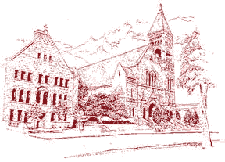Dioceses and parishes form
In the 1830s and 1840s, more and more Catholics came to live in what is now Iowa and the number of Catholic dioceses increased as their borders changed.
In 1837 the Diocese of Dubuque was created from what had been the Diocese of St. Louis. At that time, the Dubuque Diocese included all of Iowa, Minnesota, and part of the Dakotas. Later it was reduced to what is now Iowa. In 1846, Iowa became a state.
In 1856, the parish of St. Ambrose was created – serving all of Southwest Iowa! At that time, parish boundaries went as far as Fort Dodge to the north; Marshalltown, Newton and Pella to the east; the Missouri border to the south, and the Nebraska border to the west.
The first St. Ambrose church was a 40 by 24 foot wooden structure built nearby on 6th and Locust Streets. The first pastor was Fr. George Plathe. By 1865 the wooden church was replaced by a larger stone structure at that site.
In 1881, the Dubuque Diocese was split with the northern half of Iowa continuing as the Dubuque Diocese. Southern Iowa became the Diocese of Davenport, which included the Des Moines area and St. Ambrose parish.

Construction workers 1890

The Latin inscription on the cornerstone translates: ``Praise the Lord, all you nations!``
Building this St. Ambrose church
In 1890, ground was broken at 6th and High Streets to build the current St. Ambrose Church. The church opened for services in 1891.
The cornerstone states Laudate Dominum Omnes Gentes – Latin for the first line of Psalm 117: Praise the Lord all you nations.
The Diocese of Des Moines was created twenty years later (August 12, 1911) from the western part of the Diocese of Davenport. St. Ambrose was designated as the Cathedral, and the first bishop was Bsp. August Dowling.

1920s: Rectory & chapel added
The rectory building now houses our parish hall, parish offices, and Bishop’s residence.
As the Chapel of Our Lady was added to the cathedral, arches were cut into the sanctuary walls with iron grills inserted. Also, a new organ was installed.
1940s: Stained glass
Our current stained glass windows replaced the former windows. The six historical windows in the nave now depict the coming of the Catholic Church to the Americas and to Iowa and Des Moines. The ten windows in the asp are of ten events from the Gospels, each paired with an event from the Old Testament.
Further renovations included adding the Stations of the Cross and the wrought iron lanterns.
1970s: repairs and recognition
Bsp. Maurice Dingman and co-pastors Fr. John Lorenz and Fr. James Laurenzo oversaw significant repairs and renovations for a better liturgical environment. After input from the entire diocese, these renovations were completed in 1978.
The Cathedral and rectory were added to the National Register of Historic Places in March 1979.
1980: Pope’s items for the chapel
On Oct. 4, 1979, Pope Saint John Paul II celebrated Mass at Living History Farm in Urbandale. The wooden altar, chair and lectern he used are now in Our Lady’s Chapel at St. Ambrose Cathedral.
1996-97: interior
The Cathedral’s interior painting and decorating were completely renovated.
Today – for tomorrow
Major improvements to security and HVAC heating and cooling systems in both buildings were completed recently. More renovations are needed, including work on our beautiful pipe organ. Contributions are needed and welcome!
Just as previous generations created and entrusted these sacred spaces to us, it’s our turn to pass them forward in good condition that gives praise to God and serves the needs of the People of God.










